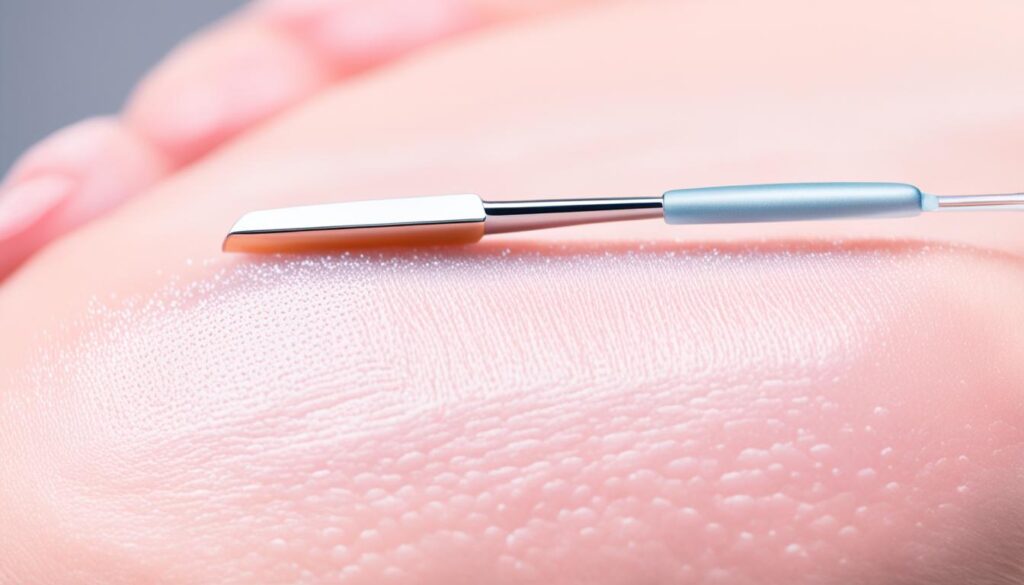If you are reading this, then you probably know dermaplaning is one of the top skincare treatments. How often should you have this treatment for better results? Dermaplaning does not need any surgery to make the skin look smoother. It involves using a super sharp scalpel that scrapes very precisely, unlike regular razors.
This treatment removes dead skin and fine hair, also known as “peach fuzz.” Depending on your skin type and how fast it regenerates, the result may last between two to four weeks.

Key Takeaways
- Dermaplaning is a non-invasive skincare treatment that exfoliates the skin and removes “peach fuzz.”
- Depending on your skin type and regeneration rate, the effects of dermaplaning can last 2-4 weeks.
- Most people will benefit from going through dermaplaning every three to four weeks for best outcomes.
- There is no fixed or optimal frequency for dermaplaning because it depends on variables like skin type and age, among others.
- To achieve the best results and avoid irritation, one should observe proper aftercare instructions provided below.
Introduction to Dermaplaning
Dermaplaning involves using a sterile scalpel to remove dead skin cells alongside villous hair called “peach fuzz.” This method makes your skin smoother without causing damage and enhances product penetration making skin glow.
What is Dermaplaning?
The technique removes the epidermis’ uppermost layer leaving a smooth surface with an even tone. It works safely on all kinds of skin, including sensitive ones, since it is delicate in nature.
Benefits of Dermaplaning
Dermaplaning has many benefits for your skin, including:
- It gives your face a polished appearance by getting rid of both dead cells as well as peach fuzz
- It helps enhance the action of products, thus fastening their response time
- This will make application of makeup much easier and thus give a perfect look
- You may see it as a way to minimize wrinkles, fine lines, and acne discoloration marks
- There will be immediate effects and you will have more radiant skin
Dermaplaning is a treatment that can adapt very well within various skincare regimes. People who desire smoother, younger-looking complexions can use this method.

The Recommended Frequency for Dermaplaning
How often should I use Dermaplane? It depends on your skin type and what you want to improve. Most experts recommend that people should undergo dermaplaning every 4-6 weeks so that their skins regenerate naturally without irritation while maintaining good results.
If you have sensitive skin, try treatments every 6-8 weeks to evaluate how well your skin tolerates them. As far as conditions like uneven color or pimples are concerned, the professional might advise receiving multiple sessions initially. Thereafter, resorting to monthly dermaplaning treatments would be appropriate.
The three-week longevity of dermaplaning results is quite typical. For many individuals out there, it becomes a monthly routine determined by the type of complexion and speed at which hair grows on their faces. In rare cases, however, complications such as infections could emerge from this process, where antibiotics or ointments would be necessary for recovery.
Only licensed professionals such as dermatologists or aestheticians should perform this procedure because of its attendant risks. Where one’s face is dry, rough, or has other flaws like scars from acne or oversized pores, it serves as an effortless way to reverse such issues.

When determining how often one should have the treatment done, make sure you talk to a skincare pro who will provide the best advice possible. They can help you get great results without putting yourself at risk if you listen carefully and alter the treatment for your skin accordingly.
Factors That Influence Dermaplaning Frequency
Finding the right dermaplaning schedule depends on several things. Your skin type, age, and lifestyle affect how often you should do it.
Skin Type
With oily skin, you might need to have dermaplaning more frequently. This helps control oil and prevents pimples. However, if you have dry or normal skin, once every 4 to 6 weeks is recommended. This removes dead skin and allows products to penetrate better. If you have sensitive skin, it may be less frequent, so consult a dermatologist before doing so.
Age
In young people, the epidermis changes faster therefore; one can do it more often in order to maintain a youthful appearance on their face. On the other hand, older skins slough off at a slower rate hence; the less often you do it, the better.
Lifestyle and Environmental Factors
The frequency of dermaplaning depends on factors such as sunburns (too much sun), wind burns (too much wind), and pollution (dirty air). If these elements surround you for most of your days, then increase your regularity of dermaplaning so as to make sure that your face is always looking attractive. Consult with a dermatology expert if you happen to suffer from acne or rosacea for advice on when it should be done.
Maintaining a routine of doing this will keep your face smooth and healthy-looking.

How Often Can You Dermaplane?
General Recommendation
Most individuals should perform dermaplaning every 3-4 weeks. This allows the natural regeneration of new skin cells without causing irritation, which enhances optimum results, though maximum protection is ensured against inflammation by performing monthly procedures that result in soft, hairless skin.
Sensitive Skin
For sensitive skin types, start carefully within six to eight weeks between treatments and observe how your complexion reacts with each passing week. Look out for signs indicating redness or sensitivity of the skin before proceeding with any treatment. Some signs may be like those observed after a breakout.
Thus, the best dermaplaning frequency for you depends on your particular skin type, age, and how it reacts to it. You can work out an appropriate schedule with a beauty advisor who is experienced in this field.
In order to derive maximum benefits from dermal planning, one should stick to the rules of proper care and ensure that they watch their skin closely so as to have a safe practice.
Express Dermaplaning: A Quick Refresh
Express dermaplaning is a quick way to freshen up your face. It lasts 20-30 minutes and immediately updates skin tone. It’s like traditional dermaplaning, which is just faster, smoothens, and rejuvenates appearance.
Benefits of Express Dermaplaning
The advantage of express dermaplaning is that it consumes less time. You will get similar results as full dermaplaning but at lower prices charged in different places. For persons who are ever busy but still wish to keep their faces looking young and smooth.
How Often to Do Express Dermaplaning
For optimal results, express dermaplaning should be done every three to four weeks. This means that patients can maintain good looks without subjecting themselves to long treatments regularly. But talk things over with experts before going through such procedures if you have peculiar skin types.
Adding express dermaplaning into your skincare routine will give you a smoother and brighter complexion. It also works well for reducing fine lines, improving the texture of the face or ensuring that aging does not take place quickly.
Maximizing the Benefits of Dermaplaning
To get the most out of your facial sessions, aftercare counts a lot, especially when coupled with other therapies while consulting skilled therapists helps one enjoy these processes fully.
Post-Treatment Care
After a dermaplaning procedure, take care of your skin. To protect it from the sun’s radiation, use hydrating serums and a broad-spectrum SPF 30 or higher sunscreen. This is particularly important to do after exfoliating. Avoid products containing retinol or acids that may irritate and over-exfoliate the skin as this will cause redness and sensitivity.
Complementary Treatments
Combining dermaplaning with other facial treatments enhances its effects. For example, try chemical peels or hydrating facials alongside dermaplaning for your face. These can help in improving the texture of the skin as well as reducing fine lines and wrinkles among other skin issues. Together, they give a more thorough rejuvenation of your skin.
Professional Guidance
One should consult skincare specialists for maximum benefit from dermaplaning procedures. They will examine your type of skin and state thereof before adjusting the kind of dermaplaning and frequency relative to you. This individualized plan ensures highest efficiency and healthy looking radiant complexion.
Focus on aftercare, add other treatments, get expert advice in order to benefit fully from dermaplaning: Consider that your needs are unique when it comes to caring for your own skin! When it comes to achieving desired results in taking care of our skins, nothing works better than consulting with a skincare professional.
Conclusion
Dermaplaning helps maintain smooth, glowing skin. This is because if you know when it should be done, then you can do much with it, as this form of skincare helps turn back time on aging skin. The experts at Glow Dermspa suggest doing this every 4-6 weeks for best results. How often: How often should I have a Derma planning? Fine lines, and acne scars, among others, are some things that can be less noticeable while making sure that all faces have equal color through this treatment.
Let the skilled estheticians help you with dermaplaning for the best skin health: Dermaplane your face regularly and specifically if it is what will make your skincare goals achievable; hence, having smooth and brighter skin for at least one month. Some people might wait longer between sessions, up to once a season, based on their skin’s needs.
Dermaplaning focuses on removing thin hair from the body, but leaves out thicker hair so that the skin remains soft. You could have to do this procedure more frequently if you have oily skin in order to prevent clogged pores as well as keep your face clear. But for people who have conditions like acne or rosacea among others, it is important to speak with an expert beforehand. Remember that the key is in how your skin feels after dermaplaning; find out what works for you and stick with it.
FAQ
What is Dermaplaning?
A gentle skincare treatment that uses a sterile scalpel to remove dead cells from the facial surface and vellus hairs.
What are the benefits of Dermaplaning?
This treatment makes your skin smoother and helps products absorb better. It also improves makeup application and reduces acne scars and fine lines. Plus, it leaves your skin looking brighter and more radiant.
How often should you Dermaplane?
How often you should use a Dermaplane depends on your skin type and concerns. Experts usually recommend doing it every 4-6 weeks. This allows your skin to fully regenerate and prevents irritation.
What factors influence the optimal Dermaplaning frequency?
Several things affect how often you should dermaplane. Your skin type, age, lifestyle, and how much you’re exposed to the environment play a role. Oily skin might need less frequent treatments, while dry or sensitive skin might need more.
Younger skin can handle more frequent sessions because it regenerates faster. But mature skin might need less.
What is Express Dermaplaning?
Quick version of dermaplaning treatment is express dermaplaning. It will take around 20-30 minutes and it makes your skin look fresh so fast. You can do it every 3-4 weeks, making it ideal for busy people who want to have smooth skin without spending long hours.
How can I maximize the benefits of Dermaplaning?
To get the best from dermaplaning, take good care of your skin after the treatment. Use hydrating serums and apply SPF daily. Mixing it with other treatments like chemical peels or hydrating facials can boost the effects. Always talk to a skincare expert to find the right frequency and type of dermaplaning for your skin.